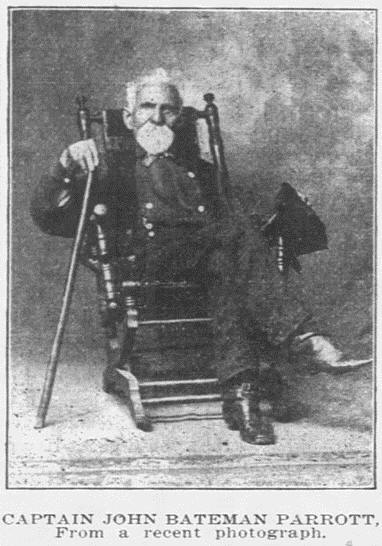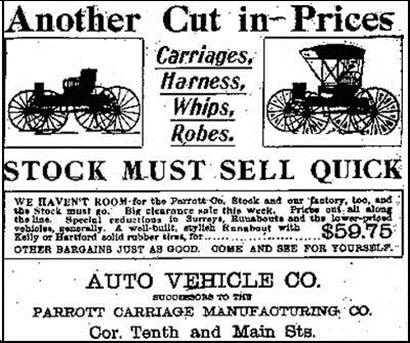An Irish PARROTT family in America
Wayne Parrott (775) investigates the family of John PARROTT from Bandon, Cork, Ireland – Family No. 003 in the Catalog of American P-rr-tt families ( http://tinyurl.com/AmericanP-rr-tts )
One of the very few Irish P-rr-tt families that came to America is that of John PARROTT (1794-1879). Despite having been in the United States for two centuries, the family has remained small – its members comprise <1% of PARROTTs living in the US today. Nevertheless, it has left its imprint on US history.
John and his brother, Matthew Jr., came from Bandon, Cork, Ireland, and settled near Bathurst, New Brunswick, Canada in 1817. From there they headed south west and moved to Coshocton, Ohio in 1837, searching for more fertile farmland.
Their father was Matthew PARROTT, who according to the family history, descended from Karey PARROTT, who “came over from England with William of Orange as an officer and helped whip the rebel Irish at the Battle of the Boyne. For his services in that war he received a large amount of land on the Eastern coast of Ireland ” in 1690.
The history continues, “the tradition in the family seven and a half plow lands; but it did us no good from the fact that a squanderer of a son named William Kearry, spent all the property except one half Plow land that one daughter got as a portion”. A plowland, or carucate, was 120 acres in size. A century and a half later, their descendant, John PARROTT, left his adopted home in Ohio and moved to Holton, Kansas in 1858. John died there in 1879. Some of his children accompanied him to Kansas; others dispersed to Iowa and California. His brother, Matthew, had no issue. Three of John’s sons are profiled in the following pages of this article.
John Bateman PARROTT (1821-1908) became an engineer in Iowa who went bankrupt building a railroad. He then joined his family in Kansas, and became a captain in the Union army during the Civil War, and after the war was over, became a revenue collector. When his wife died, he remarried, at age 83, to the widow Serena Gilman, age 82. Her husband had been a mail carrier, and she rode shotgun with him. In American English today, to ride shotgun means to ride in the front seat alongside the driver. In Serena’s day, whomever rode next to the driver held a shotgun and used it to ward off robbers and other would be villains.

Robert Bateman PARROTT (1828-1904) was one of the sons who did not move to Kansas with the family. Instead, he became an attorney and moved to Iowa, where he practiced and got elected District Attorney for the 3rd district. In 1864, he moved to Virginia City, Montana, where he set up his law practice. Once in Montana, Robert B. prospected on the weekends, and the following year discovered one of the richest copper deposits in the area. His find became known as the Parrott Copper Mine, which turned out to be the richest copper mine in the world.

Business card for Robert Bateman PARROTT printed in the Montana Post, 11 March 1865.
By 1867, mining was in full swing, and the next year, President Andrew Johnson of the United States appointed Robert to the position of Chief Justice of Montana. A few months later, Robert gave it all up and returned to Iowa, having failed to profit from his find. He returned to Des Moines, Iowa, where he remained the rest of his life. His assets were scarcely valued at $6000 at the time of his death. Yet, the mine he discovered is still in operation as the Parrot Silver and Copper Company.
Finally, William Karey PARROTT (1831-1906) moved to Sacramento, California, where his son, Karey Lee PARROTT (1863-1925) established the Parrott Carriage Co. in the late 1800s in Los Angeles, California. Newspaper accounts published as the 19th century was coming to a close suggest the company was having difficulties. In hindsight, the era of the automobile was dawning, and the future was not looking promising for horse drawn carriages.

Today, the Parrott Carriage Co. gets used as a case study of how companies use wrong strategies in the face of new technologies. Case in point, building a better buggy whip was not going to protect the company against the onset of automobiles. The next step, after focusing on the wrong product, is to slash prices. Eventually, the Parrott Carriage Manufacturing Co. was purchased by the Auto Vehicle Co., which went on to make the first automobiles produced in California.
William Karey PARROTT also had a daughter, Amanda Emaretta (Retta) PARROTT (1865-1930) who was “City Librarian, Sacramento, California, music critic and composer, author of a volume of poems, ‘Library Windows’” published in 1920. The book has recently been reprinted due to its cultural importance and is available from various outlets, or for free from Google.
